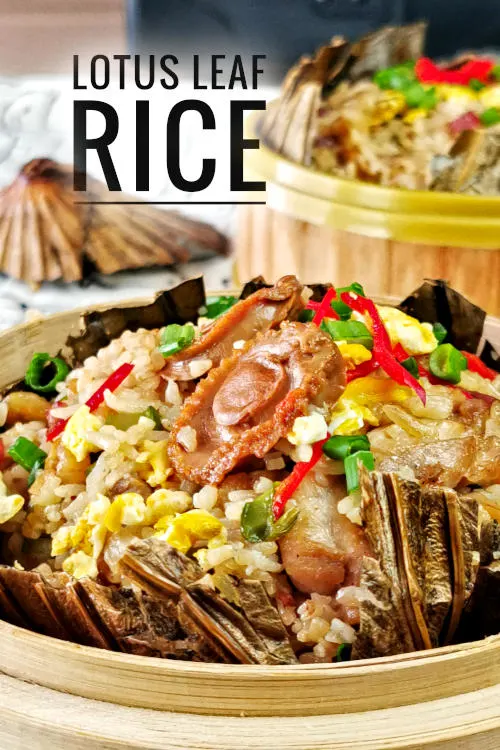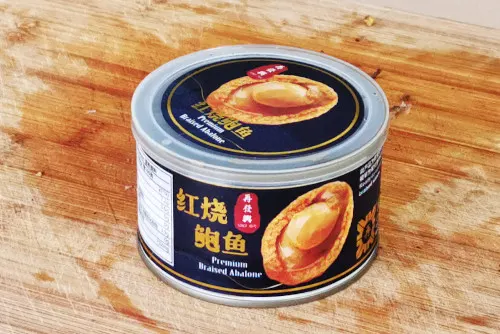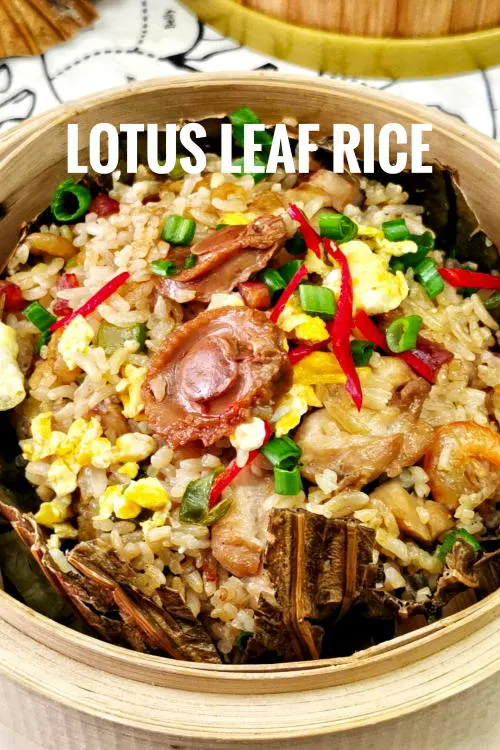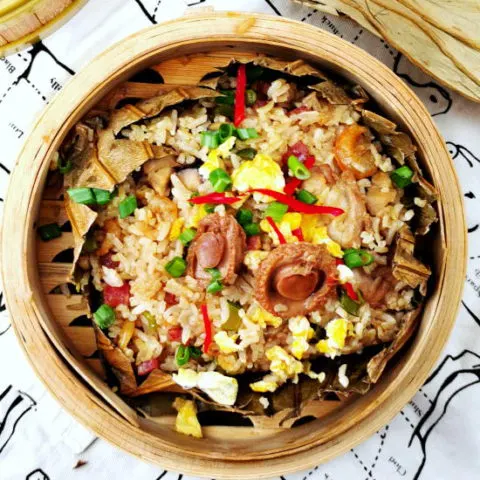Whenever I have breakfast at a dim sum restaurant, the menu often includes an exceptional rice dish that catches my attention- Lotus Leaf Rice.
This eye-catching dish comes either as a tiny rice pyramid wrapped in a lotus leaf for a single portion or a large dome served on the banquet table.
The moment you unwrap the packet, a chorus of lotus leaf aroma will hit your nose with a trove of treasure hiding in rice to be uncovered.
I will make the Lotus Leaf Rice at home today. It is ideal for any occasion, especially served during Chinese New Year’s eve, just a month away. I have added some abalone, making it an auspicious dish for this special occasion.
Let’s kick things off right away. Here are the steps to prepare the Lotus Leaf Rice
Note: This post may contain affiliate links. Please read my privacy policy for more info. I may receive commissions for purchases made through links in this post. As an Amazon Associate, I earn from qualifying purchases.

1. Soak the dried lotus leaves
It can be challenging to get fresh lotus leaves, even in Asia. Most shops do not sell this item because it is not fast-moving and will wither quickly. On the other hand, dried lotus leaves are readily available in most Asian grocery stores and Chinese medicinal shops. It is also available online.
Dried lotus leaves are pretty brittle and must be handled with care. The storekeeper near me kept them in a large drawer to avoid customers from unintentionally damaging them.
Since some of the leaves might not be perfect, it is advisable to get some extras if you need the second leaf to patch the first one during wrapping.
Here are the steps to prep the dried lotus leaves:
- First, fill a large basin or any container large enough to fit the leaves with water.
- Then, soak the dried lotus leaves until they rehydrate fully. It will take at least an hour.
- After that, bring a large pot of water to a boil. Blanch the leaves for five minutes or slightly longer until they are softened fully. The leaves may break when you use them to wrap the rice if they are still stiff and rigid.
- Remove them from the water, then clean them with a damp cloth to remove dirt.
- Trim away the excess if required. I prefer trimming the leaves according to the size needed before soaking and blanching them. This step is helpful because I do not have a large container to fit the untrimmed leaves.
2. Ingredients for the Lotus Leaf Rice
The ingredients for the Lotus Leaf Rice vary but usually include Chinese sausage, dried shrimp, and dried shiitake mushrooms.
I have added gai lan stems, chicken thigh meat, and abalone to the above ingredients. In addition, some recipes include dried scallops, carrots, shrimp, and XO sauce.
Chinese sausage
Chinese sausage is the classic ingredient for Lotus Leaf Rice. The easiest way to remove the casing of the sausage is to blanch it in boiling water for one minute. The casing will expand, and you can slip it out easily. Next, cut the sausage into small dice.
Meat
I use chicken thigh meat which is juicier than breast meat. Marinate the chicken with some salt, light soy sauce, oyster sauce, ground white pepper, and cornstarch for half an hour or more to let the flavor penetrate the meat.
If you like fresh prawns, devein and remove the shell and legs, then rub with a teaspoon of salt and let it sit for ten minutes. Salt is an effective ingredient to remove any unwanted fishy smell of the prawn. After that, wash the shrimp with water abundantly to remove the undesirable smell and salt, then drain and be ready to stir-fry.
The dried seafood and mushrooms
Clean the dried shrimp with water, then soak it for half an hour to rehydrate it before cooking. Some recipes also include dried scallops, but I omit them since I use abalone.
Soak the dried shitake mushroom until soft. The time required depends on the size and thickness of the mushroom, but generally takes at least one hour. Soaking the mushrooms in hot water can shorten the time to rehydrate them. When the mushrooms are soft, remove the stem and cut the mushroom cap into small dice.
Other ingredients
I also fry a thin omelet, then break it into small pieces as one of the ingredients, which double up as garnish.
The stem of gai lan (Chinese broccoli) is crunchy, contrasting with other ingredients, primarily soft and meaty. Cut the stem into small dice, and reserve the leaves for other dishes. French beans are a good alternative as a substitute.
Abalone is the most pricy of all the ingredients. It is usually not included in regular Lotus Leaf Rice because it is expensive. Instead, it is for special occasions such as banquet dinners or, in my case, preparing for the Chinese New Year celebration.
I use the abalone in the can, which comes with gravy. The gravy is packed with flavor and is ideal for cooking the rice as part of the liquid.

3. Cook the rice in advance
This recipe uses long grain rice instead of glutinous rice. You can make it slightly sticky by substituting ten percent of long grain rice with glutinous rice. There is a glutinous rice recipe called Lo Mai Gai on this blog that uses only glutinous rice, which is the Malaysian interpretation of Lotus Leaf Rice, by steaming it in a metal bowl without the leaf.
There is no need to soak the rice. However, it is crucial to wash the rice several times until the water runs clear before cooking it. This step is to wash away the starch on the surface of the rice grain, making each grain well separated from each other after cooking, a crucial aspect of a perfect finishing of lotus leaf rice. It also makes the rice less sticky while stir-frying in the wok.
It would help if you cooked the rice with slightly less water than the usual steamed rice because it is easier to stir-fry drier rice subsequently. Here are the steps:
- Measure one full cup of rice.
- Wash the rice with water until it runs clear.
- Remove the excess water with a strainer.
- Since I have reserved the gravy of the abalones to cook the rice, I then use the gravy as part of the liquid to cook the rice. The total amount of liquid (gravy topped up with water) to cook the rice is 1.25 cups.
- Pour the water/gravy into the drained rice and cook in the rice cooker.
- When the rice is done, let it rest and cool, then fluff the rice to let the steam escape. Dry rice is best for stir-frying as it is less likely to stick to the wok.

4. Stir-fry the rice with other ingredients
The cooking process starts with stir-frying and finishes by wrapping the rice in the lotus leaves and steaming.
Here are the steps:
- Heat some oil in the wok, then pour one beaten egg into it and immediately spread it thinly by tilting it slightly. Once the egg is set, cut it into small pieces with the wok spatula. Remove.
- Heat some oil in the wok again and saute some chopped garlic until aromatic. Keep it at low to medium heat to avoid the garlic from getting burnt.
- Add the Chinese sausage and dried shrimp. Saute for a minute or until aromatic.
- Include the mushrooms and gai lan. Continue to stir-fry for a minute. You may need to add one or two tablespoons of water if the ingredients are too dry.
- Season the ingredients with salt, light soy sauce, ground white pepper, and some Shaoxing wine. Remove all the ingredients from the wok.
- Stir-fry the chicken thigh meat with some oil until it turns slightly brown.
- Pour the rice into the clean wok with some oil, and stir fry until fragrant.
- Now, return all the ingredients (except the egg) to the wok and mix them with the rice. Turn the heat to high and stir-fry the rice until it starts to turn fragrant. Do a taste test and add some soy sauce and salt if necessary.
The fried rice is tasty and can be served as a separate dish. Wrapping with lotus leaf and steam will infuse the scent of lotus into the rice and elevate it to the next level.
5. Steam the lotus rice packets
Wrapping the rice with the lotus leaf is not difficult but can be messy if the leaf’s size does not match the rice’s amount. It is also frustrating if the leaf breaks during wrapping.
Here are the steps I took to make wrapping a smooth and effortless process:
- Use the best leaves. Pick those without visible tearing if you can choose the leaves while buying.
- Boil the leaves until very soft. The leaf is brittle, so you need to boil it for at least five minutes, even after soaking.
- Stand by the second piece of leaf. If the first leaf tears during wrapping, patch the broken part with more leaves and continue wrapping.
Here is the wrapping process:
- Trim away the excess of the leaf before wrapping. The leaves are too big for one portion unless you plan to make a huge Lotus Leaf Rice packet shared by a few people.
- Place the leaf with the tip of the stem pointing down in a shallow bowl.
- Arrange the abalone and the egg pieces at the bottom-most part of the leaf packet. The abalone and egg will be on top eventually since it is turned upended while serving.
- Add the fried rice to the leaf and press to compress it slightly.
- Fold the leaf inwards like closing an envelope.
- Reverse the packet so that the tip of the stem is facing upward.
- Place it on a plate or steamer basket, and cover it if possible to avoid water condensation from dropping onto the rice packet while steaming.
- Steam for twenty minutes over medium heat.
- Remove the Lotus Leaf Rice from the steamer. Cut off the top of the leaf to expose the rice, then garnish it with thinly sliced scallion and red chili to serve.
Note: The purpose of steaming the rice is not to cook it since it is already stir-fried. Steaming is meant to perfume the rice with the flavor and scent of the leaf. The aroma of the lotus leaf will get stronger if you steam it longer. It takes at least twenty minutes of steaming to get the rice infused with full-blown lotus leaf aroma and flavor.
Lotus leaf rice versus Lo Mai Gai
In Malaysia (where I live), Lotus Leaf Rice (荷叶飯) is not the same as Lo Mai Gai (糯米鸡). The rice used in Lotus Leaf Rice can be the regular rice of glutinous rice, but it is glutinous rice for Lo Mai Gai. Also, the main ingredient for Lo Mai Gai is marinated chicken meat and is steamed in a metal bowl rather than wrapped with a lotus leaf.
Lotus Leaf Rice is also translated as Hor Yip Fan or Lotus Leaf Wrapped Rice.

Lotus Leaf Rice- How to make it at home (absolutely delicious)
Made Lotus Leaf Rice (荷叶飯) as dim sum or for any special occasion. The rice scented with lotus leaf is incredibly delicious, with abalone, dried shrimp, Chinese sausage as the main ingredients.
Ingredients
Main ingredients (A)
Other ingredients (B)
- 3 tbsp of vegetable oil
- 1 tbsp chopped garlic
- 3 tbsp dried shrimp
- 2 Chinese sausages
- 6 dried shiitake mushrooms
- 3 tbsp gai lan stem, cut into small dice
- 1 egg
- 1 small can abalone*
- 1 tbsp light soy sauce
- 1/4 tsp ground white pepper
- 1 tbsp Shaoxing wine
- 1/4 tsp salt
Marinate the chicken (C)
- 150g chicken thigh meat
- 1/4 tsp salt
- 2 tsp light soy sauce
- 3 tsp oyster soy sauce
- 1/4 ground white pepper
- 1/2 tsp cornstarch
Instructions
Prepare the lotus leaves
- Fill a large basin with water that can fit the leaves.
- Then, soak the dried lotus leaves to rehydrate them fully. It will take at least an hour.
- Blanch the rehydrate leaves for five minutes until they are softened fully.
- Clean them with a damp cloth to remove any dirt.
- Trim away the excess if required.
Prepare the ingredients
- Blanch the Chinese sausage in boiling water for one minute. Remove the casing, then cut the sausages into small dice.
- Marinate the chicken with salt, light soy sauce, oyster sauce, ground white pepper, and cornstarch for half an hour.
- Soak the dried shitake mushroom until soft. Remove the stem, and cut the mushroom cap into small dice.
- Clean the dried shrimp with water, then soak it for half an hour to rehydrate it. Drain.
- Pour one beaten egg into the wok with some oil and immediately spread it thinly. Cut the thin omelet into small pieces with the wok spatula.
- Remove the abalone from the can. Keep the gravy to cook the rice.
Cook the rice
- Measure one full cup of rice.
- Wash the rice and drain.
- Add water to the abalone gravy to make up 1.25 cups of liquid.
- Pour the water/gravy into the drained rice and cook in the rice cooker.
- After the rice is cooked, let it rest and cool, then fluff the rice.
Stir-fry the rice
- Saute the chopped garlic, Chinese sausage, and dried shrimp until aromatic.
- Include the mushrooms and gai lan.
- Season with salt, light soy sauce, ground white pepper, and some Shaoxing wine.
- Stir-fry the chicken thigh meat with some oil until it turns slightly brown.
- Stir fry the rice in a clean wok with some oil until fragrant.
- Return the stir-fried ingredients to the wok. Turn the heat to high and stir-fry with the rice until it starts to turn fragrant.
Wrap the rice
- Place the leaf with the tip of the stem pointing down in a shallow bowl.
- Arrange the abalone and the egg pieces at the bottom-most part of the leaf packet.
- Add the fried rice into the leaf packet.
- Fold the leaf inwards like making an envelope.
- Revert the packet so that the tip of the stem is facing upward.
- Steam for twenty minutes over medium heat.
- Cut off the top of the leaf to expose the rice, then garnish it with thinly sliced scallion and red chili to serve.
Notes
*One can of abalone contains 4 abalones. Keep the gravy as part of the liquid to cook the rice.
Recommended Products
As an Amazon Associate and member of other affiliate programs, I earn from qualifying purchases.
Nutrition Information:
Yield: 3 Serving Size: 1Amount Per Serving: Calories: 607Total Fat: 35gSaturated Fat: 8gTrans Fat: 0gUnsaturated Fat: 24gCholesterol: 193mgSodium: 2115mgCarbohydrates: 41gFiber: 2gSugar: 1gProtein: 32g
This data was provided and calculated by Nutritionix on 12/31/2021





Lu Rou Fan- How to make braised pork rice (Taiwanese street food)
Sunday 30th of June 2024
[…] Lotus leaf rice– the typical Chinese dim sum wrapped in lotus leaf. […]
KP Kwan
Friday 31st of December 2021
Hi, this is KP Kwan. I am happy to see you in this comment area, as you have read through my recipe. I am glad to reply to any questions and comments as soon as possible.
Donna Masuda
Friday 18th of October 2024
Hello Mr Kwan, Been a follower of your blog for a few years and captured by your simplified methods to cooking traditional Asian foods. In 2025, may be traveling to Malaysia from Bangkok and wondered if you conduct cooking classes at any time. It would be wonderful to include that in my itinerary. Please tell me. Donna Masuda Seattle, Washington USA